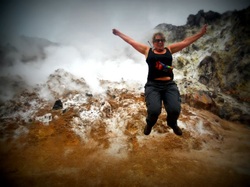
Not being a morning person, you have to give me a pretty good reason to be getting up at 5.30am and I have three!
1. Vomit Comet Avoidance -Getting up at 5.30am means we can catch the early ferry off Roatan when the sea is much calmer.
2. Volcano Boarding -Staying in Leon, rather than Comayagua, besides being in a quaint colonial city, means we will be able to tackle two additional activities... one is ‘surfing’ down an active volcano and the other is..
3. Live Lava
Everyone has agreed to a USD30 charge to bypass the usual overnight stop and head for Leon which is not on the normal itinerary. As compensation we will be able to stay in better accommodation than anticipated and because we will be using private transport the journey should be quicker. For me, the main attraction in Leon is that it is the only place in the world where you can 'surf' an active volcano and it is the only place on this trip that we will have the possibility of seeing molten magma or 'live' lava.
The GAP group have also opted for private transportation, to take them directly to Grenada to give them an extra night in the city. Grenada is a further 2 hours from Leon and we do not fancy 21hours in a bus just for an extra night in the city. Besides they will miss the volcano boarding and the lava!
But ours turns out to be also a long, long drive day and it’s 10.30pm when we wake the guards at the border crossing into Nicaragua and 01.30am when we eventually arrive at our hostel. Definitely not an upgrade but we’re too tired to complain. Anyway, for those of us volcano boarding , we only have 4 more hours before we have to be up again. Maybe it wasn’t such a good idea after all.
1. Vomit Comet Avoidance -Getting up at 5.30am means we can catch the early ferry off Roatan when the sea is much calmer.
2. Volcano Boarding -Staying in Leon, rather than Comayagua, besides being in a quaint colonial city, means we will be able to tackle two additional activities... one is ‘surfing’ down an active volcano and the other is..
3. Live Lava
Everyone has agreed to a USD30 charge to bypass the usual overnight stop and head for Leon which is not on the normal itinerary. As compensation we will be able to stay in better accommodation than anticipated and because we will be using private transport the journey should be quicker. For me, the main attraction in Leon is that it is the only place in the world where you can 'surf' an active volcano and it is the only place on this trip that we will have the possibility of seeing molten magma or 'live' lava.
The GAP group have also opted for private transportation, to take them directly to Grenada to give them an extra night in the city. Grenada is a further 2 hours from Leon and we do not fancy 21hours in a bus just for an extra night in the city. Besides they will miss the volcano boarding and the lava!
But ours turns out to be also a long, long drive day and it’s 10.30pm when we wake the guards at the border crossing into Nicaragua and 01.30am when we eventually arrive at our hostel. Definitely not an upgrade but we’re too tired to complain. Anyway, for those of us volcano boarding , we only have 4 more hours before we have to be up again. Maybe it wasn’t such a good idea after all.
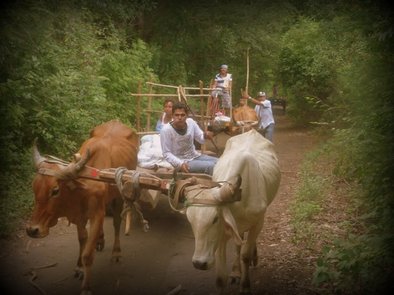
Early next morning, whilst the rest enjoy a lie-in, eight of us drag ourselves out of bed for the first real adrenalin activity of the trip.. some of us even manage to open our eyes before we get there. Once out of the city, we turn up a lane and get a snapshot of country life in Nicaragua. The side road we take is more of a lane which deteriorates into a rutted, hedged alley only a fraction wider than our 4x4. Locals are not travelling in 4x4s but on horseback, or oxen and occasionally, on a motorbike. We pass villages along the way, where children, in oversized ragged clothes, are playing in the dirt, and the men are gathered round the village well with horses or oxen towing a rope up to 100m to draw the water for the day’s needs. The women, in traditional clothing, are busy with their chores but the children run up and alongside us as we pass through, laughing and calling out. The men eye us suspiciously, until they recognise our guide, Miguel, to whom some call out a friendly greeting. When we get to the end of the lane and climb out into the chilly morning, what appears in front of us appears to be an oversized coal slag heap, with big, dark boulders scattered all around.
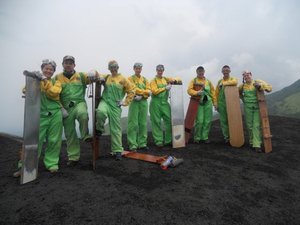
This is Cerro Negro (Black Hill), Nicaragua’s youngest, and most active volcano, standing a mere 728m high, though it looks much bigger. The summit is out of view hidden by the light mist which covers it like a blanket. It’s hard to see how we will scale this almost vertical slope with no clear path visible, let alone a ski-lift, to take us and our boards to the top.
Miguel gives us the bad news. We will have to carry our own boards and protective clothing and climb the volcano surface to the top. As we set off the rain starts to fall and before long we’re a pretty soggy party staggering up the barely visible path, around and over boulders and up the slippery slope. As we climb around and up the volcano, the rain and mist start to lift and we get a greater appreciation of the volcano (which is dark and lava gravel coated) and the surrounding countryside which evidences older volcanoes covered in lush, green vegetation. Eventually we reach the lower rim of the volcano crater and can see down into the crater itself. No lava visible here but lots of red and white boulders with white steam, or is it smoke, billowing out of many points where the crust is particularly thin. It’s like a different planet. Cerro Negro last erupted in 1999 but is closely monitored with experts predicting another large eruption very soon. We’re not daunted and a few of us manage to persuade Miguel to take us down a path into the crater. It’s not recommended, due the instability of the crater surface and the very real risk of death, so the others decide to remain on the relative safety of the rim. Down in the crater, we can feel the heat, and by the steam vents it is unbearable. There are a couple of large boulders so we decide to take some ‘jump’ photos from the boulders. As we land, we can hear a hollow echo beneath us. Time to make a quick exit! We scurry back the crater rim and start the climb to the far side where the rim is much higher.
Miguel gives us the bad news. We will have to carry our own boards and protective clothing and climb the volcano surface to the top. As we set off the rain starts to fall and before long we’re a pretty soggy party staggering up the barely visible path, around and over boulders and up the slippery slope. As we climb around and up the volcano, the rain and mist start to lift and we get a greater appreciation of the volcano (which is dark and lava gravel coated) and the surrounding countryside which evidences older volcanoes covered in lush, green vegetation. Eventually we reach the lower rim of the volcano crater and can see down into the crater itself. No lava visible here but lots of red and white boulders with white steam, or is it smoke, billowing out of many points where the crust is particularly thin. It’s like a different planet. Cerro Negro last erupted in 1999 but is closely monitored with experts predicting another large eruption very soon. We’re not daunted and a few of us manage to persuade Miguel to take us down a path into the crater. It’s not recommended, due the instability of the crater surface and the very real risk of death, so the others decide to remain on the relative safety of the rim. Down in the crater, we can feel the heat, and by the steam vents it is unbearable. There are a couple of large boulders so we decide to take some ‘jump’ photos from the boulders. As we land, we can hear a hollow echo beneath us. Time to make a quick exit! We scurry back the crater rim and start the climb to the far side where the rim is much higher.
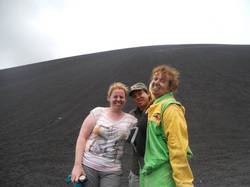
Then it’s time to don our fabulous green boiler suits, elbow and knee guards, eye masks and gloves. Looking gorgeous, and ready for action, I peek over the edge. It’s very steep and the jeep waiting for us at the bottom looks so small it’s difficult to make out. Well ...maybe I’ll just walk back down the way we came. Miguel gives us a quick briefing on how to descend, how to brake and how to go faster. Faster? I don’t think so. I decide that I’ll just go down with my feet out to brake and take it easy. No shame in that. One by one the others set off, sat down on their boards like a sledge, until there’s just Dan and me left. Dan is the only one brave enough to go standing up. David has set off just in front of me and is braking hard, travelling only a few metres before coming to a slow halt. Ok. So at least I know it’s possible to have control. Courage Vicki! I set off, with my feet stretched out clear in front of me, for balance. At least I can brake quickly if I need to. Twenty metres down and I come to a halt, my board buried under the black gravel. This is no good. I’ll never get down at this rate and Dan is already catching me up. I lean back as far as I can to lift the front of the board to clear it and hold it up as I start to slide rapidly down the hill, gathering speed as I go, flying down. Wheeeeeeeee! I open my mouth to scream with exhilaration at the speed . BIG mistake. I get a mouth full of black ash and quickly close it again. As I gain momentum, the ash penetrates everywhere. I can feel it in my shoes, inside my jumpsuit, in my gloves, up my nose, in my ears, on my mouth, between my teeth and even in my eyes inside the goggles... Then, just as I’m really starting to enjoy it, I’m at the bottom, it’s all over and we’re watching Dan surf gracefully down. Looking round it’s like a Minstrels revival, with black faces and white eyes and teeth, except for Dan, who still looks squeaky clean.
We head off back down the lane, past the village where a baseball match has just kicked off. The modern baseball team kit they are wearing seems incongruous with the traditional clothing and antiquated lifestyle we witnessed earlier but baseball is a huge sport here in Nicaragua.
We head off back down the lane, past the village where a baseball match has just kicked off. The modern baseball team kit they are wearing seems incongruous with the traditional clothing and antiquated lifestyle we witnessed earlier but baseball is a huge sport here in Nicaragua.
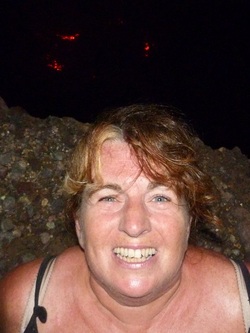
By the time we get back to base, we’ve only got a quick turnaround before we need to leave for the next volcano adventure, a twilight climb of Telica (Black Hole). Fortunately, there’s a great pizzeria two doors down, so we order our pizzas and grab a quick shower whilst we’re waiting.
Then it’s back in the jeeps for the 30km drive to the volcano. Once off the main road we drive up a narrow lane which gradually gets worse as we go. Our driver shifts into 4WD and we are thrown from side to side across the vehicle as he negotiates the deep ruts left by the heavy rains and climbs the hill leading to the base of the volcano.. At times it feels like the jeep will tip over on its side but eventually we reach a clearing in the woods and the jeeps come to a halt. Our hike starts here. Making sure I have water and my head torch, I regret not finding time to purchase a few snacks as it will be a long evening. The hike starts with a gentle climb up the original lane through the lowland woods, until we exit the woods and have stunning views of the surrounding volcanoscape. Many of the other slopes are covered in lush vegetation, but the lower slopes of Telica remind me of the hills I hike at home in Snowdonia, rocky outcrops, low bushes and short grass, but with a few more lava bombs or boulders. To our right it’s hard to tell whether the cloud from the crater is rain or gas but as it comes closer, the sulphur hits the back of our throats. Miguel guides us further round the slope to avoid it and I realise that, in the rush, I have also forgotten my scarf to protect me from inhaling the sulphur. As we climb the slope, the grass disappears and we are clambering up the rocks to the first ridge, where we stop for a brief rest to drink and snack and to assess the viability of accessing the crater with the possible rain cloud on one side the crater gases on the other. With a high blanket of cloud there is no possibility of any sunset either but we can feel the chill in the air as twilight approaches. The goats nibbling at grass tufts in an old crater nearby ignore us as we ponder the options. But as dusk falls, the rain cloud dissipates and the gas cloud seems to disappear as well. We continue to climb to the rim of the main crater. It’s difficult to explain the feeling as we reach the rim. There’s no ‘Elf & Safety’ here. No steps to the top. No protective hand rail. No gas masks nor hard hats. Just nature and us, balanced precariously on the edge of a 120m vertical drop into molten rock at 1200C. In fact, the rock we are standing on juts out so we are not even on a solid cliff edge. As the sky darkens the magma glows more brightly and, as it swells up and recedes far below us, in the stillness of the night, it sounds like the ocean waves on the beach. Above us, the thunder crashes and lightning cracks the night sky but instead of the downpour we’re expecting the sky clears to reveal the twinkling stars. We could spend all night here staring into the bubbling magma but supplies of water are completely depleted and we still need a couple of hours to descend.
No moon to guide us as we make our descent over rocks and rubble, stumbling and slipping as they wobble beneath unsteady feet. Even our guide, Miguel, occasionally loses his footing and with no visible path down I stick close behind him, shadowing his footsteps with my own. It seems to take forever before we reach the main track back to the vehicles and as I head the line back through the forest, I see eyes everywhere in my torch light, and fireflies occasionally dancing off before me .The soft dampness of thread glistening with evening dew tickling my face as I break through the spider webs in the path. Once in the jeeps, we have to negotiate the deep ruts of the track descent in pitch dark. It’s even more hazardous and several times we are left wondering if our friends behind have come to grief as the headlights of their jeep behind us disappear for several minutes. Back in town we only have a few minutes to claim our rucksacks and jump on the bus to our next stop.. the oldest city in the New World, Granada
Then it’s back in the jeeps for the 30km drive to the volcano. Once off the main road we drive up a narrow lane which gradually gets worse as we go. Our driver shifts into 4WD and we are thrown from side to side across the vehicle as he negotiates the deep ruts left by the heavy rains and climbs the hill leading to the base of the volcano.. At times it feels like the jeep will tip over on its side but eventually we reach a clearing in the woods and the jeeps come to a halt. Our hike starts here. Making sure I have water and my head torch, I regret not finding time to purchase a few snacks as it will be a long evening. The hike starts with a gentle climb up the original lane through the lowland woods, until we exit the woods and have stunning views of the surrounding volcanoscape. Many of the other slopes are covered in lush vegetation, but the lower slopes of Telica remind me of the hills I hike at home in Snowdonia, rocky outcrops, low bushes and short grass, but with a few more lava bombs or boulders. To our right it’s hard to tell whether the cloud from the crater is rain or gas but as it comes closer, the sulphur hits the back of our throats. Miguel guides us further round the slope to avoid it and I realise that, in the rush, I have also forgotten my scarf to protect me from inhaling the sulphur. As we climb the slope, the grass disappears and we are clambering up the rocks to the first ridge, where we stop for a brief rest to drink and snack and to assess the viability of accessing the crater with the possible rain cloud on one side the crater gases on the other. With a high blanket of cloud there is no possibility of any sunset either but we can feel the chill in the air as twilight approaches. The goats nibbling at grass tufts in an old crater nearby ignore us as we ponder the options. But as dusk falls, the rain cloud dissipates and the gas cloud seems to disappear as well. We continue to climb to the rim of the main crater. It’s difficult to explain the feeling as we reach the rim. There’s no ‘Elf & Safety’ here. No steps to the top. No protective hand rail. No gas masks nor hard hats. Just nature and us, balanced precariously on the edge of a 120m vertical drop into molten rock at 1200C. In fact, the rock we are standing on juts out so we are not even on a solid cliff edge. As the sky darkens the magma glows more brightly and, as it swells up and recedes far below us, in the stillness of the night, it sounds like the ocean waves on the beach. Above us, the thunder crashes and lightning cracks the night sky but instead of the downpour we’re expecting the sky clears to reveal the twinkling stars. We could spend all night here staring into the bubbling magma but supplies of water are completely depleted and we still need a couple of hours to descend.
No moon to guide us as we make our descent over rocks and rubble, stumbling and slipping as they wobble beneath unsteady feet. Even our guide, Miguel, occasionally loses his footing and with no visible path down I stick close behind him, shadowing his footsteps with my own. It seems to take forever before we reach the main track back to the vehicles and as I head the line back through the forest, I see eyes everywhere in my torch light, and fireflies occasionally dancing off before me .The soft dampness of thread glistening with evening dew tickling my face as I break through the spider webs in the path. Once in the jeeps, we have to negotiate the deep ruts of the track descent in pitch dark. It’s even more hazardous and several times we are left wondering if our friends behind have come to grief as the headlights of their jeep behind us disappear for several minutes. Back in town we only have a few minutes to claim our rucksacks and jump on the bus to our next stop.. the oldest city in the New World, Granada
 RSS Feed
RSS Feed
